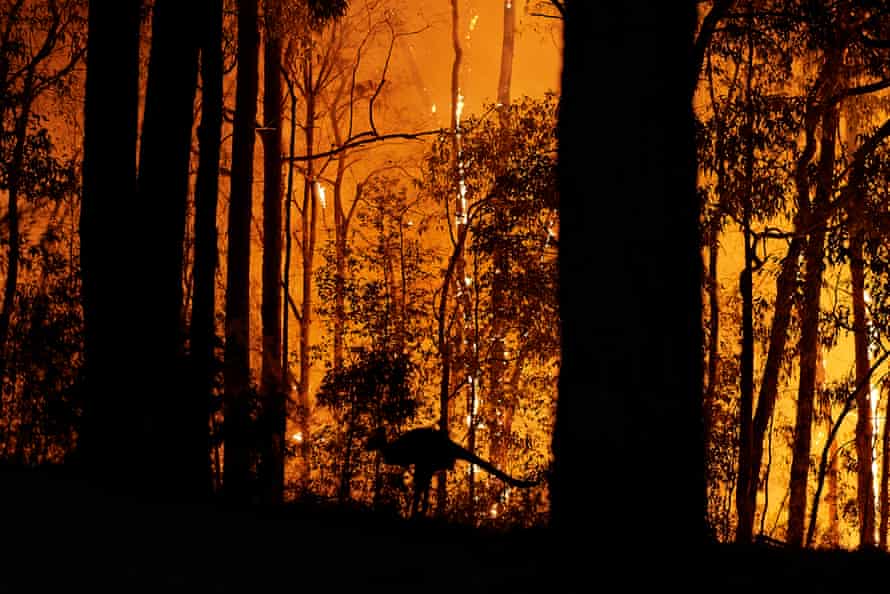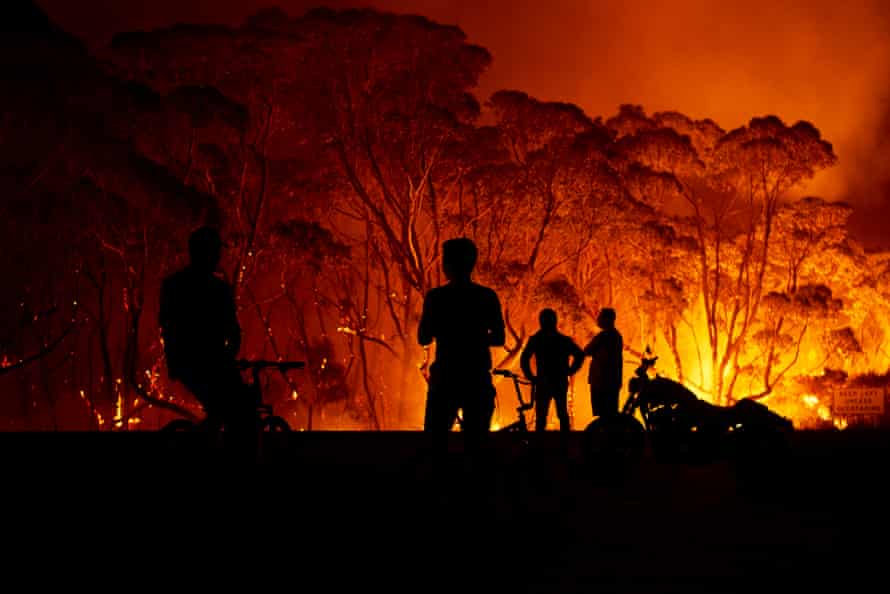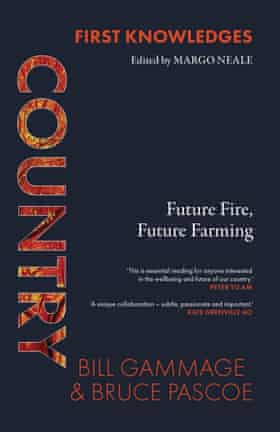Bill Gammage and Bruce Pascoe: Indigenous care for country could rescue us all

In this extract from a new book, the co-authors look to lessons of the past to examine the best way forward in land management after the fires of Black Summer
In Aboriginal thought, Country is a term which embraces everything spiritual and material. In our book Country: Future Fire, Future Farming, we illustrate its range and power by showing how Australia’s first peoples managed plants and animals, and how they managed and used fire.
We demonstrate the impressive and extensive skills and knowledge the First Australians, “the people of 1788” used to manage land. Together – Bill writing about fire, and Bruce about plants and animals – we show how much those who invaded after 1788 ignored and degraded those skills.
Finally, we argue that with proper recognition as intellectual property, those skills should be used to benefit, even to rescue, all Australians now and in future.
Bill Gammage: past fires as lessons for the future
Fires need fuel. Big fires need a lot of fuel. What people did in 1788 until newcomers began stopping them reduced and dispersed fuel, breaking it up with grazed grass and open forest. That changed almost everywhere in Australia after 1788. Huge tracts now carry much more fuel than they did, letting fires run, unstoppable, for hundreds of kilometres. It didn’t need anything particularly special to spark Black Summer’s 2019-20 fires, just drought, hot winds and fuel. Sooner or later, climate change or not, the bush burns. Our task is to reduce fuel while maintaining the beauty and diversity of our plants and animals.
Like the Dreaming, like Songlines, Black Summer showed us past, present and future. We saw the consequence of our neglect, the devastation that caused, and a warning for the years ahead. We saw immense human effort, courage, mateship, skill, wondrous firefighting equipment and technology, strong community support, an international rally of resources, and huge expense. The result? The worst fires we’ve ever had. We’re getting nowhere. Not every summer will be as terrible as 2019-20, but big fires come faster and faster upon us. This is our country to care for, but we can’t do it. We live with a national disgrace.
Fire has always been part of being Australian, but what that means has been upended since 1788. Then it meant maintaining an alliance; now it means fighting an enemy. Or, to judge from some responses to Black Summer, dodging an enemy. The prime minister claims, “We have had bushfires before and will have them again, nothing to see here, this is all part of a normal cycle”, then for the cameras obliges stricken survivors to shake his hand. A scientist declares control burns “not the answer” yet adds that they have not been properly tested, even though Black Summer delivered the biggest field trial in our history. Others have the gall to say publicly that control burning costs too much. What price Black Summer?
Experts, including senior fire professionals, told the 2020 royal commission that control burning is not safe or useful. One said, ‘The weight of research into the effects of fuel reduction on the propagation of extreme bushfires, indicates that as conditions deteriorate, fuel reduction is of diminishing effectiveness, and may have no appreciable effect under extreme conditions.” You could step over a 1788 grassfire: what is the point of confining remarks to “extreme conditions” when fuel reduction intends to ensure that there are none? What research prompted these bumbling and pointless remarks? None from Aboriginal fire experts. None from the record of history. None from the 1939 royal commission which declared, “It is long established by foresters in other parts of the world that in [extreme] conditions … [fuel reduction] is the only effective safeguard.”
Climate change surfaced quickly as a culprit: “a climate-change induced inferno ripped through New South Wales and Victoria”. “Climate-change induced”? No big fires before climate change became apparent? No 1851, 1898, 1926, 1939, 1944? All those killed people and burnt homes and hectares aplenty. It matters to know what “induced” them.
Climate change is a real and urgent danger. Black Summer was south-east Australia’s longest and harshest fire season. It generated an unimaginable 20 pyrocloud storms, when fire takes over the weather. It killed fewer people but destroyed more homes, killed more wildlife, and in the south-east ruptured more Songlines and incinerated more sacred places than any before it. Yet to suggest that what happened 50, 100, 150 years ago was not enough to warn us of fire’s danger ignorantly denies our fire history. We were warned. Our fault was not being caught by surprise, but not confronting what we knew was coming.

Big fire years are stepping stones in white Australia’s history, each a lesson for the future. In Victoria on 6 February 1851, a suffocating day in a drought summer, hot northerlies linked up fires in remote bush that had been let burn for months. One started when bullock drivers left burning logs untended in the Plenty Ranges, and the wind took it racing away. From north-east to south-west a boomerang of fire took hold. The sky darkened, birds in flight dropped dead, thick smoke reached northern Tasmania, and a ship 20 miles (32km) off the Portland coast was drenched in burning embers. William Howitt reported, “300 miles in extent, and at least 150 [generally more like 50] in breadth, was reduced to a desert. It was one blackened and burning waste … the country was actually one blaze for thousands of square miles.” Twelve people died, over a million sheep, and uncounted thousands of cattle and wildlife.
This fire was only 16 years after newcomers reached Victoria. It fed on crops and hay as well as forest and scrub, but its speed and extent so soon showed how readily the bush leaps into deadly flame. The next big fire, also in Victoria, was not until 1898, and for a century after 1851 all the big fires were in Victoria (1898, 1926, 1939, 1944, 1951-52). Extraordinary. Were newcomers in 1851 taught a lesson they remembered for 50 years, then forgot? If so, the lesson was not climate change, but fuel.
Significant elements of 1851 recurred in later big fires: a drought summer, remote fires let burn, a hot peak day (47C in 1851 v 45C in 2019-20), hot northerlies, red flame leaping, distant places choked with smoke and showered with embers, spot fires, homes burnt, people killed. In January 1939 the fires leaped from mountain peak to mountain peak, or far out into the lower country, lighting the forests 10 or 11km in advance of the main fires … Houses of brick were seen and heard to leap into a roar of flame before the fires had reached them … in many places, hundreds of trees of great size were blown clear of the earth, tons of soil, with embedded masses of rock, still adhering to the roots.
That matches Black Summer intensity well before global warming was apparent.
But the 1851 and 1939 fires lasted a few days and peaked in one or two. 1851 burnt about 5m hectares, about 22% of Victoria; 1939 burnt uncounted “millions of acres”. Terrible, but much less than the 1974-75 inland fires which burnt about 117m hectares, or Black Summer which lasted six months and burnt over 24m hectares, more than all Victoria. In the years between, the climate got hotter, and the fuel load got bigger. Today we don’t hope to reverse global warming, only to limit or stabilise it by some future decade. We could start reducing fuel now.

Bruce Pascoe: rethinking land care
In the aftermath of the fires, Mother Earth invited us into the forest and insisted that we observe her recovery, her power. The tree ferns were first, generating celebratory, bright-green fanfares of promise against a background of ash and char where the giant spars of fallen trees were like a graveyard for burnt galleons. Rushes thrust up spears of electric green and then epicormic shoots appeared on the eucalypts; bronze, pink and vermilion flames licked at the blackened trunks. Later the wattles and kangaroo apples sprang up from seed they had cast after the blaze.
The vivid response revived us a little and we went looking for seedlings. The forest floor was studded with emergent green: ironbarks, peppermints, hickory wattles, casuarinas, cherries and brave maidenhairs. We wanted to use these seedlings to rebuild burnt areas and enhance others, and as we lifted and potted plants our spirits rebounded a little. When we combed our croplands to study the species’ recovery we were charmed and exhilarated to find apple berry, glycines and lomandras and stunned to see so many orchids where we had never seen them before. We had removed cattle from Yumburra two seasons earlier in order to rest and revive the soil and then the fires suppressed some common weeds, which allowed our own fire-resistant plants to flourish. The leek orchids were lush and plump and we marvelled at the revelation of what a fire and the removal of hard-hoofed animals could do.
Those fires also burnt our crop of kangaroo grass and it felt like a year of work had been in vain. I felt devastated for the community, but only weeks later, and with the benefit of a good rain, the grasses were back and booming without competition from the exotics. We were able to harvest two different grasses, mamadyang ngalluk and garrara ngalluk, in June 2020, and by the end of the year we also had buru ngalluk prospering. It was remarkable to see tall grasses coming back, not just at the edge of the forest but deep inside it. We had seen some examples of garrara ngalluk on roadsides but by November it was dominant at the edge of the forest, and within the forest it was growing strongly. This was a surprise as we’d never seen it under the trees before. The canopy of the bigger trees had been eliminated by the fire and so plants we didn’t recognise as forest plants were flourishing. We also found a lot of manjamanja ngalluk. All of these grasses were used by our old people to produce flour.

The presence of all these plants growing in the forest after the fires provided us with an opportunity to re-examine our land use. This type of growth is what the first “explorers and pioneers” observed and what Bill Gammage outlined in The Biggest Estate on Earth. Australian colonists ignored the First Peoples’ style of management and went straight to replicating the systems of the lands they had left, as if they had moved next door, not to another hemisphere. They began ploughing soil and planting exotic food plants, and almost completely ended the use of fire in the landscape.
We need to change our thinking about how to farm the country. Aboriginal people managed and harvested these lands in common. When farmers began to use tractors directed by satellite navigation about 30 years ago, they pulled down fences between properties so that the huge machines could harvest in straight lines over hundreds of kilometres, 24 hours a day. It was an economically rational idea. We may not be able to replicate the ancient common wealth, but perhaps new methods and new crops will allow us to do more things in common and with less machinery, fuel and soil compaction.
The fires of 2019-20 gave us a little clue to the alternative. Harvesting between trees is not what our monocultural system believes in, but having a forest and food on the same land provides an opportunity to reassess forest management. Since the cessation of regular applications of cool fire, Australians have argued about fuel loads and mismanagement. Not all forests will be suitable as food forests and this can be gauged from the fact that before 1788, Aboriginal people chose to work the more manageable slopes and temperate forests.
Conservationists need not fear that all nesting sites and diversity will be lost, as this type of forest nurtured the diversity that the colonists encountered on their entry into the country. For example, bandicoots and potoroos were abundant in the precolonial forest but have all but disappeared due to our subsequent land use and the presence of cats and foxes. We now know that bandicoots are crucial to soil health because they assist the spread of mycorrhizal fungi and aerate the ground more deeply. They are adapted to grasslands in open forest and we miss their contributions to our soil health.
After the fires we were thrilled to see indigenous grasses come back to the forest. It vindicates our decision to try to return the forest on our farm to one where big trees and food grasses dominate. This doesn’t mean we will lose our wattles and grevilleas, indigoferas and hakeas: the biodiversity will remain, but we’ll end up with a productive and far less flammable forest.

We intend to remove the smaller eucalypts from our farm’s forest lands and sell the timber as sawlogs. Already we have used a lot of this timber to build fences and sheds on the farm. It’s a slow process and won’t be achieved overnight, but we are trying to reverse the poor land-management decisions of the last 230 years.
We are experimenting with an adaptation of our harvester so that we can harvest grasses within the forest, not just in open country. If we are successful, it may provide us with an opportunity to change the idea of how to farm this continent.
These are edited extracts from Country: Future Fire, Future Farming by Bill Gammage and Bruce Pascoe, edited by Margo Neale co-published by Thames & Hudson Australia and National Museum of Australia. Available 26 October 2021